A quick answer: Yes, requiring an NDA (Non-Disclosure Agreement)1 is essential when sourcing OEM padel rackets to protect proprietary designs, safeguard intellectual property, and mitigate supply chain risks.
In today’s competitive sports equipment market, OEM sourcing2 requires careful risk management—especially in the dynamic field of padel racket manufacturing3. Businesses must protect sensitive design details, production techniques, and strategic business information. One way to achieve this is by incorporating a robust NDA as part of your supplier agreements. This article explores the necessity of NDAs, analyses associated risks, and provides a step-by-step solution for enhancing legal safeguards during the OEM procurement process.
The overall goal of an NDA is to secure your intellectual property (IP)4 and trade secrets during OEM sourcing. In industries like padel equipment, where product design, material choice (ranging from fiberglass to 3k, 12k, and 18k carbon fiber), and manufacturing techniques are key differentiators, the wrong information leak can damage long-term brand value. Below are key reasons why NDAs are indispensable:
- Intellectual Property Protection: When you share your custom designs, production techniques, or innovative technologies with manufacturers, you expose yourself to potential IP theft. An NDA legally binds the supplier to confidentiality, reducing the risk of unauthorized dissemination.
- Competitive Advantage Maintenance: Your design and production process are often major competitive advantages. Implementing an NDA protects these secrets from being replicated by competitors.
- Supply Chain Integrity: In OEM sourcing, especially when engaging with global partners who may have varying legal frameworks, an NDA establishes common ground in legal expectations. This can reduce regulatory inconsistencies and ensure your business practices are protected.
- Risk Mitigation: By clearly outlining what constitutes confidential information and the consequences of any breach, NDAs help manage operational and legal risks. Effective risk control improves supplier relationships and builds trust.
For companies sourcing from diverse manufacturing hubs, several underlying issues necessitate an NDA for OEM sourcing:
- Cross-Border Legal Complexities: International manufacturers might operate under different legal regimes, making IP protection challenging. An NDA sets clear confidentiality standards regardless of local legal practices.
- Exposure of Sensitive Data: Sharing custom padel design blueprints and production specifications can inadvertently lead to the theft or misuse of intellectual property if not properly secured.
- Non-Specific Contractual Clauses: A standard commercial contract may not sufficiently address the nuances of intellectual property and trade secrets. An NDA specifically focuses on confidential data, leaving no ambiguity regarding its protection.
- Risk of Imitation: As some manufacturers also serve multiple brands—including competitors—an NDA limits the risk of design imitation and technology transfer.
A practical, step-by-step approach to integrating an NDA into your procurement process includes the following solutions:
| Step | Action | Benefit | Key Considerations |
|---|---|---|---|
| 1. Identify Confidential Information | Compile a list of all proprietary designs, production processes, and technology data. | Clear understanding of what needs protection. | Be comprehensive: include designs, material specifications, and custom manufacturing techniques. |
| 2. Draft a Customized NDA | Work with legal experts to create an NDA tailored to the padel racket industry. | Ensures legal validity and industry relevance. | Consider jurisdiction-specific clauses if working with international manufacturers. |
| 3. Negotiate Contract Terms | Engage suppliers early to explain the importance of confidentiality. | Establishes mutual understanding and buy-in. | Clarify penalties and legal remedies for breaches in the agreement. |
| 4. Implement and Monitor | Integrate NDA signing into the onboarding process of OEM partners. | Continuous protection of sensitive information. | Regularly review and update the agreement as business needs evolve. |
| 5. Training and Compliance | Educate internal teams and suppliers about confidentiality importance. | Minimizes internal lapses or misuse of information. | Regular compliance checks can prevent data breach events. |
Implementing these solutions establishes a strong legal foundation that protects both parties involved in OEM sourcing. It is crucial to view the NDA not merely as a formality, but as an integral part of your overall risk management strategy.
-
Enhanced Trust with Partners: Signing an NDA signals to your business partners that you take confidentiality seriously. This can foster a more trusting, long-term relationship with suppliers such as those engaged by NEX Padel. Strong supplier relationships are vital for ensuring product quality and on-time delivery.
-
Legal Recourse in Case of Breach: An NDA provides clear legal remedies if a breach occurs. This acts as a deterrent against the misuse of proprietary information. In essence, having a properly drafted Non-Disclosure Agreement ensures that you are not left without recourse should any confidentiality breach compromise your business.
-
Clear Communication of Expectations: A well-defined NDA outlines what information is considered confidential and how it must be handled. This clarity helps avoid misunderstandings between your organization and the manufacturer, ensuring that both parties adhere to strict data handling practices.
-
Facilitates Transparent Operations: When entering an arrangement with a supplier, having a signed NDA makes intellectual property protection a shared responsibility. This transparency can be a strong bargaining tool, particularly in negotiations over design modifications, customization options, and joint development projects.
-
Streamlines Decision-Making Processes: With legal safeguards in place, procurement teams can make faster and more confident decisions when selecting OEM suppliers. Knowing that there is an NDA in place reduces the hesitation that may arise from potential IP risks. This facilitates quicker turnaround times and accelerates the supply chain cycle.
For decades, high-performance padel racket manufacturing has been a closely guarded secret among top manufacturers. Take, for example, an OEM sourcing strategy employed by NEX Padel. By integrating strict NDA clauses into all their supplier contracts, NEX Padel has effectively minimized the risk of IP leaks, ensuring that proprietary technologies remain secure. This practice not only preserves the company’s competitive edge but also supports long-term partnerships with reputable brands like Hirostar, Reebok, and Starvie which demand precise and high-quality products.
Moreover, industry data shows that companies with strong legal safeguards in place achieve a higher rate of successful product launches. Surveys conducted among sports equipment manufacturers indicate that over 70% have instituted NDAs to mitigate risk during early design station phases. These practices underline the growing trend of legal compliance and risk management in padel equipment sourcing. By following these industry benchmarks, procurement specialists can align their operations with best practices, reducing unforeseen liabilities and ensuring smooth OEM collaborations.
While NDAs offer extensive protective benefits, it is important to adopt a balanced approach during negotiations. Consider the following caveats:
-
Mutual Trust and Relationship Building: An NDA is a legal instrument and not a substitute for building genuine trust with your manufacturer. Assess the supplier’s reputation, and ensure that they have a reliable track record in handling confidential data.
-
Ensuring Fair Contract Terms: Overly strict NDAs might deter potential suppliers who are concerned about overly rigid clauses. It is important to strike a balance between protecting your interests and allowing flexibility for creative collaboration.
-
Legal Jurisdiction Challenges: When dealing with international suppliers, ensure that the NDA accounts for varying legal enforcement mechanisms. It may be necessary to include mediation or arbitration clauses to address cross-border disputes.
-
Document Management: Continuous monitoring is essential. Implement systems to manage and update confidential information as products and designs evolve. Regular audits of compliance can help detect early signs of breach or lax management of sensitive data.
Based on the analysis of risk management practices in padel equipment sourcing, here are a few actionable steps for businesses looking to secure their intellectual property during OEM procurement:
- Initiate early discussions about confidentiality requirements with your shortlisted suppliers.
- Involve legal experts to draft a customized Non-Disclosure Agreement tailored to the specifics of padel racket production.
- Educate your procurement and design teams about key aspects of confidentiality and data protection.
- Regularly monitor supplier compliance and be willing to renegotiate terms if market conditions or business needs change.
- Align your supplier selection process with industry benchmarks to ensure that you are sourcing from trustworthy and legally compliant manufacturers.
Taking proactive steps in integrating NDAs significantly boosts your overall risk management strategy. This not only secures your proprietary designs and production processes but also provides a solid foundation for transparent, long-term OEM partnerships.
The role of an NDA in the OEM sourcing process for padel rackets is not merely a legal formality—it is a fundamental aspect of protecting your business interests, maintaining competitive advantage, and establishing transparent supplier relationships. By understanding the risks involved and implementing robust NDAs, companies like NEX Padel have set industry benchmarks in safeguarding innovations and ensuring smooth production processes.
Businesses involved in padel racket manufacturing should consider the NDA as a critical tool in their procurement toolkit. This measure provides clarity, reinforces legal accountability, and ultimately contributes to the efficient, secure operation of the supply chain. We encourage business development managers and procurement specialists to review their existing contracts and work closely with legal advisors to integrate these protective measures into all OEM supplier agreements. Making this a priority today means safeguarding your company’s vision and ensuring ongoing success in a highly competitive market.
People Also Ask
Q: Is an NDA really necessary when engaging with padel racket manufacturers?
A: Yes, an NDA is vital as it legally binds manufacturers to keep design and production details confidential, thereby protecting your unique intellectual property and competitive advantage.
Q: What are the key benefits of using an NDA in OEM sourcing for padel equipment?
A: The main benefits include enhanced trust with suppliers, clear legal recourse in case of data breaches, transparency in handling sensitive information, and alignment with industry best practices to mitigate supply chain risks.
Q: How can a business ensure that their NDA is effective across international borders?
A: To ensure an NDA is effective internationally, work with legal experts to draft jurisdiction-specific clauses, include mediation or arbitration provisions for dispute resolution, and regularly review compliance with international legal standards.
-
NDA (Non-Disclosure Agreement): Click to learn about the framework that legally binds parties to confidentiality, protecting sensitive business information in complex supplier relationships. ↩ ↩
-
OEM sourcing: Click to understand the process of procuring products from Original Equipment Manufacturers and the associated risk management strategies. ↩ ↩
-
padel racket manufacturing: Click to explore the niche industry of padel racket production, including design considerations and manufacturing best practices in sports equipment. ↩ ↩
-
intellectual property (IP): Click to get insights on safeguarding creations, designs, and proprietary technologies critical to maintaining competitive advantage in business. ↩ ↩







